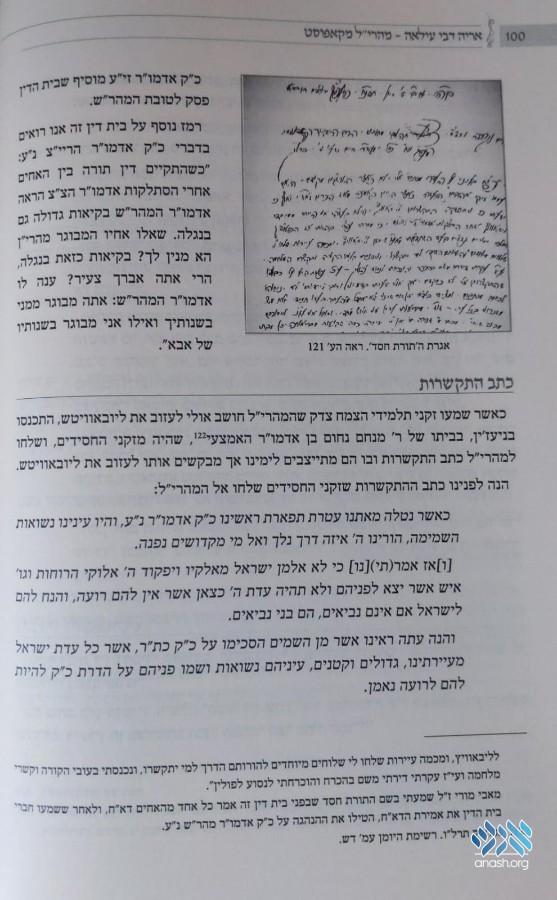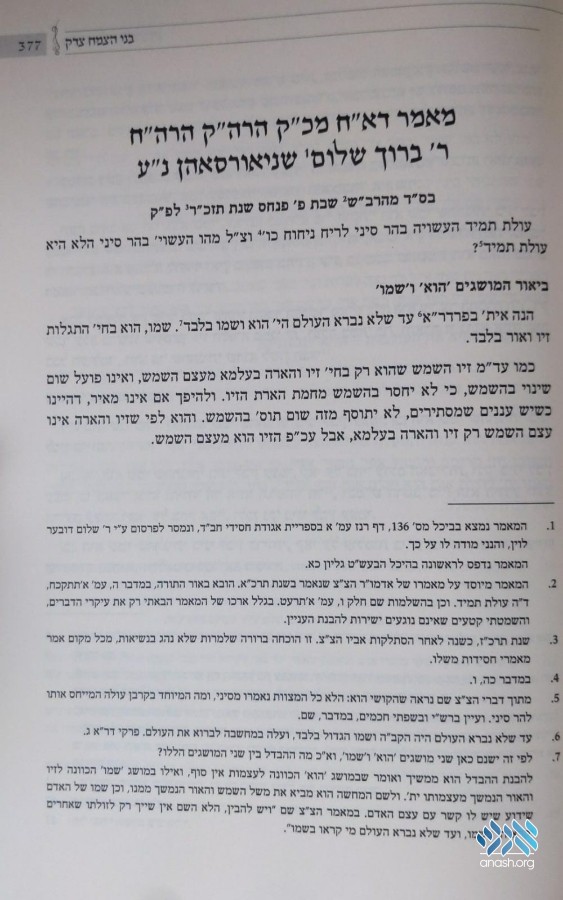י״א אלול ה׳תשפ״א | August 18, 2021
How Much Do You Know About Kopust?
A Look Inside the Book: Today, Chabad and Lubavitch are synonymous. But for a significant period of Chabad history this was not the case. A newly published book tells the story of the sons and grandsons of the Tzemach Tzedek who led other Chabad groups.

A Look Inside the Book: Today, Chabad and Lubavitch are synonymous. But for a significant period of Chabad history this was not the case. A newly published book tells the story of the sons and grandsons of the Tzemach Tzedek who led other Chabad groups.
By Shmuel Super
Benei Hatzemach Tzedek
Rabbi Amram Bloi
Maayontecha, 5781
508 pages
Introduction
Today, Chabad and Lubavitch are synonymous. But for a significant period of Chabad history this was not the case—alongside Lubavitch, several other Chabad groups flourished, led by the sons and grandsons of the Tzemach Tzedek. Rabbi Amram Bloi’s masterful Benei Hatzemach Tzedek tells this little-remembered fascinating story for the first time.
In the past, Lubavitcher chassidim generally did not discuss this topic much. It is no secret that there were periods of tension and points of contention between Lubavitch and the other Chabad courts.
But the Frierdiker Rebbe, and especially our Rebbe, displayed a conciliatory attitude towards the other Chabad Rebbes, even referring to them with the title of ,כ”ק אדמו”ר an honorific they generally reserved for our Rebbeim. When the editors of kovetz Yagdil Torah placed a letter by one of the other Chabad Rebbes in the section for “Chassidim Harishonim,” the Rebbe instructed it be moved to the section titled “Rabboseinu Nesi’einu” (Avodas Hakodesh, p. 23).
The Rebbe explained that the split within Chabad was not a machlokes in the simple sense, it was a division leshem shamayim. As such, both sides are destined to endure for eternity (Sichos Kodesh 5752, p. 11-12). The different streams of Chabad, the Rebbe said, have since flowed into and merged with the great river of Lubavitch, under the leadership of the Frierdiker Rebbe (Toras Menachem 5713, vol. 3, p. 57).
The story of the sons and the grandsons of the Tzemach Tzedek and the chassidim they led is thus a part of our broader history as Lubavitchers. Even on the most simple level, our Rebbe was a direct descendant of the Tzemach Tzedek’s oldest son Harav Baruch Sholom; the Frierdiker Rebbe was the grandson and namesake of Harav Yosef Yitzchak of Avrutch; and the Rebbetzin was a descendant of Harav Yisrael Noach of Niezhin. Many Lubavitcher chassidim today are similarly descended from chassidim of the different branches of Chabad.
Overview
In this review, we will begin with an overview of the methodology of Benei Hatzemach Tzedek, continue to survey its contents, and conclude with some comments on the editorial process.
Benei Hatzemach Tzedek originated with a series of articles by R. Amram Bloi in the Heichal Habaal Shem Tov journal (vol. 15-23). R. Bloi was a trained historian, and in his later years he published many articles on Chabad history, the history of the yishuv in Yerushalayim, and other topics of historical interest.
The research into the different branches of Chabad was the pinnacle of R. Bloi’s work, and the introduction to the book tells us that he had begun editing this work for publication in book form. After R. Bloi’s tragic death in a road accident in 5779, his grandson Menachem Mendel Bloi completed the job. A biographical chapter about R. Bloi appears at the beginning of the book.
R. Bloi’s work is unique due to his ability to draw together disparate sources and weave them into one cohesive narrative.
Benei Hatzemach Tzedek draws extensively from traditional internal Chabad sources, of which there are three primary channels: the traditions of Beis Harav as related by the Frierdiker Rebbe in his voluminous writings, the stories related by the mashpia in Lubavitch R. Groinem (preserved in the books written by his students, such as Shemuos Vesipurim, Reshimos Devarim, etc.), and the stories of R. Mordechai Yoel Duchman transcribed in Lesheima Ozen.
R. Bloi is able to use this large and disparate body of stories to paint a detailed picture of a person by identifying defining characteristics expressed by multiple stories, and presenting them to the reader in a logical order.
The novel element of R. Bloi’s work lies in the external sources he brings to the table. He draws extensively from eyewitness accounts published in memoir literature, newspapers, and journals, by people that had first hand encounters with the holy protagonists of this book.
These sources are very important in order to paint a full historical picture of these tzadikim. Traditionally chassidim didn’t place an emphasis on the details of history and externalities, focusing on Torah and avodas Hashem. The stories they told were for the purpose of learning from tzadikim, not learning about them. This focus is perhaps best illustrated by the many examples in this book of biographical details such as years of birth, marriage, etc. that we only know from the titles of maamarei Chassidus delivered on these occasions.
The outside sources R. Bloi cites give incredible descriptions of every element of the courts of the Tzemach Tzedek and his descendants, describing their appearances, conduct, and teachings in intimate detail. For us materially grounded readers, these depictions draws us into the atmosphere of the chatzer, and develop a feeling for the tzadikim described.
Of course, these external sources need to be used with great caution. Most of these accounts were written by outsiders, or by insiders who left. As a result, their accounts are colored by their perspectives and agendas, which are often very distant from the chassidishe world they are writing about. R. Bloi perfected the art of discernment, extracting the valuable fruit of these accounts, while discarding their shell.
Another unique source of information for R. Bloi is archival material, drawn primarily from the archives of the National Library of Israel. This material includes previously unpublished writings of chassidim and outsiders, as well as Russian governmental records.
Benei Hatzemach Tzedek masterfully weaves all of these sources into a seamless tapestry. Written with a rare combination of historical scholarship and chassidishe reverence, we are presented with clear living portraits of the tzadikim and nuanced descriptions of their individual personalities and character traits. The book is thoroughly researched, but it is not dry and technical and will be an enjoyable read even for those not inclined towards the minute details of history.
The Sons of the Tzemach Tzedek
We will now turn to survey the content of the book, highlighting the way in which the previously mentioned sources are used.
Benei Hatzemach Tzedek begins with an introductory chapter about the later years of the Tzemach Tzedek’s nesius, laying out the background for the story of the division of Chabad.
We learn that already during the lifetime of the Tzemach Tzedek his sons filled rebbe-like functions. They each had their own shuls in Lubavitch, taught their father’s maamarim, and visited outlying communities on their father’s behalf, where they would say Chassidus and even accept panim.
These underlying facts are established based on Reshimos Hayoman and other internal sources, but they are then brought to life with an eyewitness account from the memoir of R. Pinchas Goldenshtein, a non-Chabad chasid who later served as a shochet in Petach Tikvah. This account provides a detailed description of Tzemach Tzedek’s delivery of the maamar and the chazaros each of his sons made separately, at their homes.
A collection of stories from Chabad sources illustrates the relationship between the Tzemach Tzedek and his sons, highlighting the importance he ascribed to their learning and davening.
These internal stories about the spiritual dimension are then followed by a carefully curated selection from the writings of contemporary misnagdim and maskilim who visited the Tzemach Tzedek’s chatzer and gave accounts describing the external dimension of its functioning.
Worthy of special mention is one lengthy incredible account by a maskil describing his wondrous yechidus with the Tzemach Tzedek, the delivery of the maamar, the yoshvim and their davening. This account also describes the Tzemach Tzedek’s sons, their ages, physical appearances, and a personal conversation with Harav Yisrael Noach, later of Niezhin, and a meal in his house.
A quote from a Russian government report describing the great respect chassidim accorded the Tzemach Tzedek and his sons concludes this chapter.
The following five chapters introduce us to each of Tzemach Tzedek’s sons, except for the Rebbe Maharash, who has already been written about at length in Lubavitch sources.
The Tzemach Tzedek’s oldest son Harav Baruch Sholom—the Rebbe’s great-great grandfather—was the only one son who did not become a Rebbe of chassidim after his father’s passing, and even during his father’s lifetime was less involved in communal affairs. A number of stories describe his deep humility.
Nevertheless, both before and after his father’s passing, R. Baruch Sholom did travel to outlying Chabad communities, saying chassidus and accepting panim. The aforementioned R. Goldenshtein met with R. Baruch Sholom on one of his journeys and describes his appearance, scholarship, and humility. Interestingly, this source—among others—describes how together with his berachos, R. Baruch Sholom would also dispense medical prescriptions for health issues. He passed away only three years after his father.
The second son, Harav Yehudah Leib, known as Maharil, was the most prominent son during most of the lifetime of the Tzemach Tzedek. Maharil had a particularly close relationship with his grandfather the Mitteler Rebbe, and a number of stories show how Maharil was an even closer talmid of his grandfather than he was of his father.
Maharil was known for his very intense avodas hatefilah in the style of the Alter Rebbe, with great visible excitement, completely oblivious to his surroundings. An eyewitness account describes his conduct on his journeys among the chassidim, including a moving description of his emotional reading of the haftorah.
Before the passing of the Tzemach Tzedek, Maharil was the best known of his sons. Upon the Tzemach Tzedek’s passing machlokes broke out among the chassidim, primarily between supporters of Maharil and the Rebbe Maharash. R. Bloi describes this episode sensitively and respectfully, based on letters and documents from the time, including archival material first published here.
Due to the machlokes, Maharil moved to Kopust, and most of the Tzemach Tzedek’s chassidim accepted his leadership. The first Tishrei in Kopust was attended by masses of chassidim, but the great excitement quickly turned into deep mourning, as Maharil passed away shortly after yom tov, only months after his father.
The chapter about Maharil concludes with a list of some of his prominent chassidim with brief biographical information, some brief pisgamim from him, and stories about him. The other chapters in the book conclude similarly.
The Tzemach Tzedek’s third son Harav Chaim Shneur Zalman was also a prominent figure in his father’s lifetime. A few years after the Tzemach Tzedek’s passing he moved to Liadi, and R. Bloi quotes from a beautiful description of the great joy in Liadi when R. Chaim Shneur Zalman arrived to settle there.
His avodas Hashem was also with great excitement and dveikus, and we read a vivid description of him singing nigunim, saying chassidus, davening, yechidus, and the life in his chatzer. This is probably the most incredible account in the book, and it draws the reader in to feel the experience.
The fourth son of the Tzemach Tzedek was Harav Yisrael Noach, known as Maharin. Maharin stood out as a gaon in nigleh, and was entrusted by his father to respond to many of the halachic questions sent to him from across Russia, especially during the Tzemach Tzedek’s later years. He also headed a local Yeshivah in Lubavitch and gave semicha to aspiring rabbonim.
R. Bloi briefly describes the content of some of Maharin’s teshuvos and analyzes his approach, identifying an inclination to search for leniency in difficult situations. These teshuvos have been published in various journals, and it is hoped that they will one day be collected and published properly, together with the teshuvos written by his brothers, perhaps as a hosafah to the new edition of the teshuvos of their father, the Tzemach Tzedek.
A few years after the Tzemach Tzedek’s passing, Maharin moved to Niezhin at the invitation of the chassidim who lived in the Ukraine, far from the other centers of Chabad. In Niezhin he served as rebbe, and a posek. Maharin passed away in 5643 and was particularly mourned by all Chabad chassidim, as he was the last of the Tzemach Tzedek’s sons to pass away, a few months after his younger brother the Rebbe Maharash.
The fifth son of the Tzemach Tzedek, Harav Yosef Yitzchak, is probably the least known of the sons. R. Yosef Yitzchak also served as a chassidic rebbe, in the town of Avrutch, but unlike his brothers, he was a not a Chabad style rebbe. A son-in-law in the Chernobyl dynasty, he served as a rebbe in the Chernobyl tradition.
R. Yosef Yitzchak’s leadership began during the lifetime of his father the Tzemach Tzedek and was subject to machlokes in Chernobyl. The Tzemach Tzedek was not pleased with this, and R. Bloi quotes from his letters to his son and explains the episode with characteristic sensitivity and honesty. Rebbetzin Shterna Sarah was R. Yosef Yitzchak’s daughter, and the Frierdiker Rebbe was named after him.
The Grandsons of the Tzemach Tzedek
A further six chapters tell the stories of the grandsons of the Tzemach Tzedek that functioned as rebbes.
The first chapter in this section is dedicated to Harav Shlomo Zalman of Kopust, the oldest grandson of the Tzemach Tzedek and for many years the most prominent Chabad Rebbe.
Four years older than the Rebbe Maharash, R. Shlomo Zalman grew up in the chatzer of the Tzemach Tzedek with whom he had a very close relationship, and was treated like one of the sons.
R. Shlomo Zalman went with his father Maharil to Kopust, and was broken by his sudden passing. His subsequent letter to his chassidim describes this as the end of an era in the history of chassidus. This sentiment, that the rebbes following the Tzemach Tzedek were of a different level, appears to have been common among many Chabad chassidim of all types.
The leadership of R. Shlomo Zalman was focused on chassidus and counseling his Chassidim, and he was not very involved in general communal affairs. His humility and politeness was often misrepresented as endorsement, and in an important section his stance concerning Zionism is clarified. Initially supportive of settlement in Eretz Yisrael, together with many other prominent Rabbonim, he turned against it when the relationship with the secular Zionists became clear.
Maamarim of R. Shlomo Zalman were published in Magen Avos, and the Rebbe once commented that these are very geshmake maamarim, based primarily on maamarim of the Tzemach Tzedek. (Hamelech Bemesibo, vol. 2, p. 84).
The chapter also contains a general discussion of the affiliations of chassidim in different towns, and concludes with sichos and stories related by R. Shlomo Zalman, many published from manuscript.
The second son of Maharil was Harav Sholom Dovber of Retzitza. A few years after the passing of his father, he moved to Retzitza where he served as a Rov and rebbe. After the passing of Maharin, many of the chassidim in the Ukraine area came to his chatzer. The chapter includes a lengthy description of him during the time of the Russian revolution and pogroms, by his grandson Dr. Fishel Schneerson.
A large chapter is devoted to Harav Shmaryahu Noach of Bobroisk, the third son of Maharil. A few years after his father’s passing, R. Shmaryahu Noach of moved to Bobroisk as the rov of the local chassidishe community. During this time he said chassidus, but only began to function fully as a rebbe after the passing of his brother R. Shlomo Zalman of Kopust when many Kopuster chassidim turned to him as their rebbe.
An important part of R. Shmaryahu Noach’s activity was the kibutz he established. This was a Yeshivah for older bochurim, less organized and supervised than Tomchei Temimim in Lubavitch. Many important rabbonim studied under him and received semicha from him, such as Rav Shlomo Yosef Zevin and Rav Nisan Telushkin.
R. Shmaryahu Noach was very active in communal affairs. His involvement in the battle for shechitah, assisting Jewish soldiers, and other communal matters is described in this chapter. His stance in the rabbinic conference of 5670 regarding secular education for rabbonim is also explained.
Another section in this chapter respectfully describes the machlokes regarding Colel Chabad in Eretz Yisrael, in which R. Shmaryahu Noach prioritized the yishuv in Yerushlayim, while the Rebbe Rashab prioritized Chevron.
With the passing of R. Shmaryahu Noach in 5683, an era in Chabad history drew to a close. He had been the last of the Chabad rebbes outside of Lubavitch, and from this point on Lubavitch and Chabad became synonyms again. The Rebbe assisted in the publication of R. Shmaryahu Noach’s maamorim under the title Shemen Lamaor.
This part of the book concludes with shorter chapters about three other grandsons of the Tzemach Tzedek who served as rebbes. Harav Yitzchak Dovber (Maharid) succeeded his father R. Chaim Shneur Zalman in Liadi, and is best known for his commentary on the siddur according to Chassidus, Sidur Maharid (published in a new edition by Machon Oholei Shem, 5751).
We also learn about a little known figure, Harav Levi Yitzchak of Siratshin. R. Levi Yitzchak was a descendent of a Polish Chassidic dynasty who became a chassid and son-in-law of R. Chaim Shneur Zalman of Liadi, and after his father in law’s passing served as a rebbe in Siratshin, according to the Chabad style.
The final chapter tells the story of the son and successor of R. Yosef Yitzchak of Avrutch, Harav Nachum Dovber, who served as a rebbe in the Chernobyl tradition.
Appendices
The Rebbe once expressed his desire to publish one maamar from each of the sons of the Tzemach Tzedek (Hamelech Bemesibo, vol. 1, p. 211). Accordingly, Benei Hatzemach Tzedek book includes one maamar from each of the sons and grandsons of the Tzemach Tzedek who said chassidus in the Chabad style. The editing of these maamarim is not uniform; some have detailed footnotes and others none at all.
Four other articles by R. Bloi on topics related to the book also appear as appendices. One in-depth chapter explores the concept of hiskashrus in Chabad thought and highlights the chidushim of R. Shlomo Zalman of Kopust in this area.
Another appendix studies the life and thought of R. Yaakov Yisrael of Cherkas, the son of R. Mottele Chernoblyer, and son-in-law of the Mitteler Rebbe, showing how fundamental Chabad concepts are reflected in his teachings. The relationship between Chabad and Radzimin is the focus of another appendix.
The book concludes with a chapter about R. Menachem Nochum, the son of the Mitteler Rebbe, and his descendants who served as rebbes in the Chernobyl style, under the name of Tomoshpil.
Editorial Comments
As mentioned at the beginning of this article, the content of Benei Hatzemach Tzedek was initially published in installments in Heichal Habaal Shem Tov, and reedited for publication in book form.
Now that the articles have been published as a complete book, the absence of chapters providing a broader overview of the period in general is felt. Such chapters could have explored what it meant to be a chassid of a rebbe in this period of division, how chassidim from one group viewed the rebbes of the other groups, and how fluid were the boundaries between them—as we find chassidim who maintained a connection with multiple chatzeiros.
Another question readers may have after reading this book is why all of the other branches of Chabad died out while Lubavitch survived and thrived. The answer to this question appears to be the high rates of attrition among the youth as the winds of modernity swept through Russia, with haskalah, communism, and secular Zionism attracting many young people. The anti-religious persecution of the communist regime was the final nail in the coffin.
Lubavitch was the exception to this trend due to the siyata dishmaya of the Rebbe Rashab and the Frierdiker Rebbe, the sharp ideological sense of mission they imparted to their chassidim, and their success in establishing Tomchei Temimim to educate bochurim to these ideals and serve as a bulwark against outside influences.
The graduates of Tomchei Temimim were fortified with the strength and mesiras nefesh to withstand foreign ideas and government oppression, and they perpetuated Lubavitch into the modern era. It is noteworthy that many of the talmidim of Tomchei Temimim came from the other branches of Chabad, including some of the grandchildren of the other rebbes.
Such broader chapters of analysis would have made this excellent book even more valuable, but unfortunately its author passed away without being able to write these chapters.
The editor added a few pictures to the chapters, but other visual elements could have been added as well. For example, a timeline with the important milestones in the life of each tzadik at the beginning of the chapter would have helped contextualize them in time. Many readers aren’t familiar with the meaning of old geographical labels such Lita, Raysen, and Malarussya, and maps showing the regions and cities mentioned would have helped readers contextualize matters geographically.
The original articles in Heichal Habaal Shem Tov generated much learned feedback in the journal, and corrections and additions could have been made based on this material. For example, a response in Heichal Habaal Shem Tov clarified the details of the wives and children of Maharin of Niezhin, and added another eyewitness account of him.
Occasionally the dates for events discussed are not given in the right place, leaving the reader unclear about the progression of events. For example, no year is given when R. Yosef Yitzchak’s move to Avrutch is discussed, and only at the end of the chapter can readers deduce this information, when we are told that he passed away in 5636 after leading his chassidim for 18 years.
It is hoped that the Bloi family will continue and publish further books collecting R. Amram’s other scholarly articles on Chabad history and other topics.
Conclusion
Benei Hatzemach Tzedek is an excellent, groundbreaking book that tells the fascinating story of a little-known yet important period in Chabad history. Anyone with an interest in Chabad history and chassidishe stories will thoroughly enjoy this book.
Benei Hatzemach Tzedek can be purchased here.
‘A Look Inside the Book’ is a bi-weekly feature on Anash.org, taking a look at what’s new in the shelves of Seforim stores.





When is the translation coming?
וואו קראתי את הספר, והוא חובה לכל חסיד שמתעניין בדברי הימים